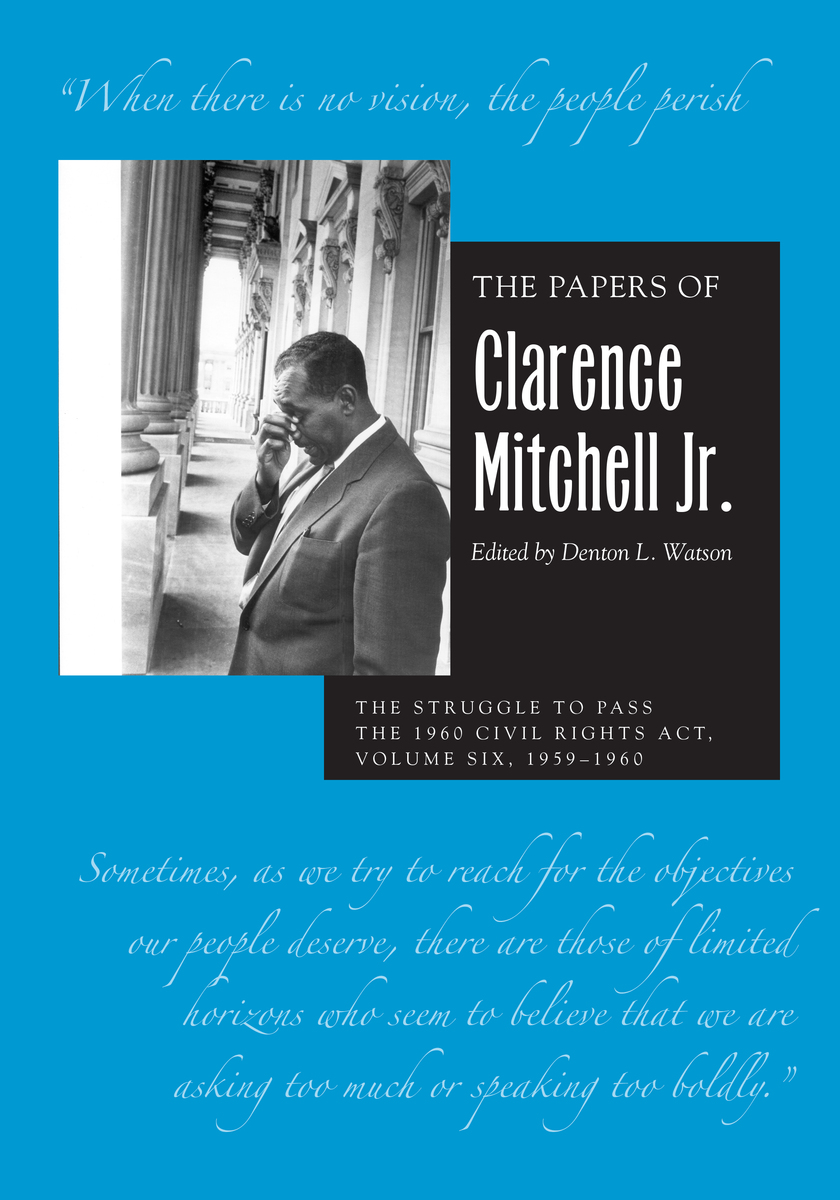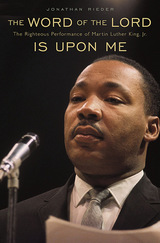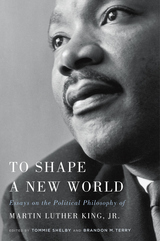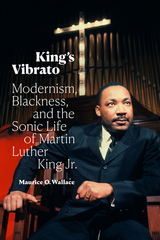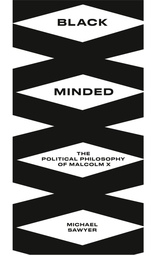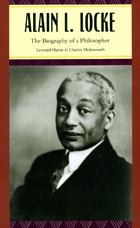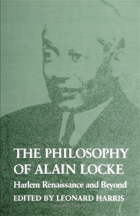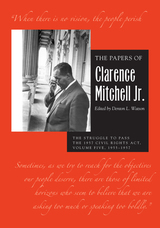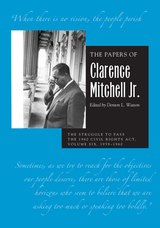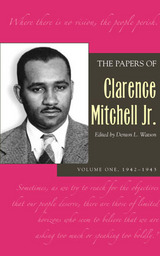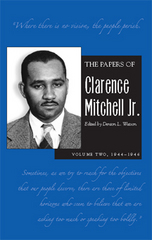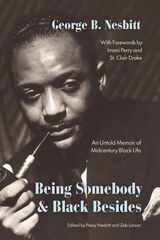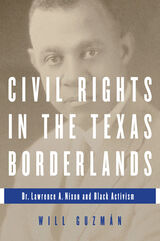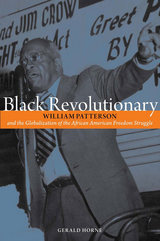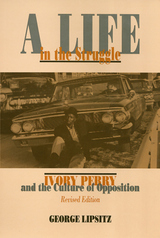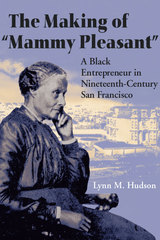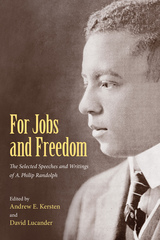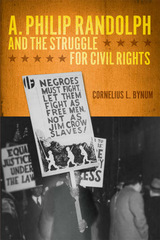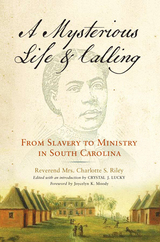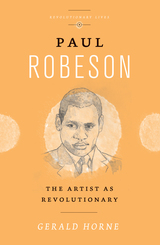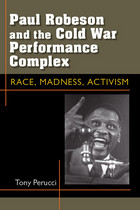Contents
List of Illustrations 000
Foreword 000
Preface 000
Acknowledgments 000
Introduction: The FEPC Years 000
Editorial Method and Abbreviations 000
FEPC Chronology 000
FEPC Personnel List 000
Headnotes
Jurisdictional Issues 000
Relationships with Federal Agencies 000
Creedal Discrimination 000
National Origin, Alienage, and Loyalty 000
Race, Creed, Color, or National Origin on Employment Application Forms 000
Japanese Americans 000
Mexican Americans 000
The Mining Industry 000
The Oil Industry 000
The Aircraft Industry 000
The Shipbuilding Industry and the Boilermakers Union 000
The Steel Industry 000
Street and Local Railways 000
The Telephone Industry 000
Major Cases in St. Louis 000
The FEPC and Unions 000
Strikes and Work Stoppages 000
Documents
Prologue: The Home Town?s Race Problem 003
1942
Memoranda of Clarence M. Mitchell Jr. as Field Assistant and Assistant Chief under Robert C. Weaver, Chief of the Negro Employment and Training Division, Office of Production Management and War Production Board
January 23, 1942, Memorandum on COFEP Complaint against the International Telephone and Radio Manufacturing Corporation and the Federal Telegraph Company, East Newark, N.J. 000
January 27, 1942, Memorandum on Westinghouse Employment Situation 000
February 2, 1942, Memorandum on COFEP Request from Mr. Eugene Davidson 000
April 23, 1942, Memorandum on the Brecon Bag Loading Plant, Flora, Mississippi 000
Memoranda of Clarence M. Mitchell Jr. as Principal Fair Practice Examiner, Fair Employment Practice Committee (FEPC)
ca. October 10, 1942, Memorandum on Portland, Oregon, Shipyards 000
November 28, 1942, Memorandum on Suspension of War Training for Negroes in Alabama 000
December 4, 1942, Memorandum on Wage Rate for Harvesting Sugar Cane in Florida and Louisiana 000
December 14, 1942, Memorandum on U.S. Postal System 000
December 17, 1942, Memorandum on Proposed Directive to Mr. F. G. Seulberger, Chairman Department of Industrial Relations, Northwestern University 000
December 23, 1942, Memorandum on Tennessee Valley Authority Employment Practices 000
December 28, 1942, Memorandum on Railroad Complaints 000
December 28, 1942, Memorandum on Complaints against the Chesapeake and Potomac Company in Baltimore, Maryland 000
1943
January 11, 1943, Memorandum on Firms with Fair Employment Practices 000
January 11, 1943, Memorandum on Aircraft Training in Atlanta, Georgia 000
January 18, 1943, Memorandum on Request for Information from Mr. Kasper, Editor of the Employment Security Review 000
January 18, 1943, Memorandum on Telephone Conversation with Cy W. Record 000
January 19, 1943, Memorandum on Stabilization Agreements 000
January 25, 1943, Memorandum on National Defense Research Committee 000
February 5, 1943, Memorandum on Telephone Call from Mr. Cy Record in Atlanta, Georgia 000
February 24, 1943, Memorandum on Savannah Shipyards 000
March 3, 1943, Memorandum on Employment of Negroes in Savannah, Georgia 000
March 5, 1943, Memorandum on Susceptibility of Negroes to Industrial Diseases 000
March 10, 1943, Memorandum on [Section 35(A) of United States Criminal Code] 000
March 13, 1943, Memorandum on Additional Members of the President?s Committee on Fair Employment Practice 000
March 16, 1943, Letter to Lee Seitzer on Discriminatory Practices of Shipyards 000
March 23, 1943, Memorandum on Visit to New Britain Machine Company, New Britain, Connecticut, March 18, 1943 000
March 24, 1943, Memorandum on Declaration of Citizenship 000
March 29, 1943, Memorandum on Conversation with Cy W. Record 000
[March 1943], Memorandum on Material to Be Submitted for the War Manpower Commission Report 000
April 5, 1943, Memorandum on Staff Meeting of March 29, 1943 000
April 13, 1943, Memorandum on Labor Stabilization Plans 000
April 16, 1943, Memorandum on Defense Training in States with Separate Schools 000
April 17, 1943, Memorandum on Civil Service Regulations on Japanese Employment 000
April 26, 1943, Memorandum on Agreement on Importation of Bahamian Workers 000
April 28, 1943, Memorandum on Staff Meeting of April 12, 1943 000
May 1, 1943, Memorandum on Compliance and Analysis Report on Six New England Companies 000
May 4, 1943, Memorandum on [Stabilization Agreements] 000
May 6, 1943, Memorandum on Staff Meeting of April 26, 1943 000
May 8, 1943, Memorandum on Employment of Negroes in Street Railways 000
May 10, 1943, Memorandum on Staff Meeting of May 3, 1943 000
June 1, 1943, Memorandum on Conditions at the Alabama Shipbuilding and Dry Dock Company as of May 31, 1943 000
June 28, 1943, Memorandum on Executive Order 8802 as It Affects Bahamian Labor 000
June 28, 1943, Memorandum on Long Distance Call to Lewis W. Clymer, Region IX 000
ca. July 1943, Memorandum on Supplementary Training at the Alabama Dry Dock and Shipbuilding Company 000
July 5, 1943, Memorandum on Conference Regarding Chesapeake and Potomac Telephone Company 000
July 5, 1943, Memorandum on Complaint of Mrs. Laurence Walker, Milton, Pennsylvania, against the Philco Radio Corporation, Watsontown, Pennsylvania 000
Reports and Headquarters Memoranda of Clarence M. Mitchell Jr. as Associate Director of Field Operations, FEPC
July 12, 1943, Memorandum on Conference with the War Department Representatives, July 12, 1943 000
July 16, 1943, Memorandum on Strike at American Steel Foundry Plant, East Chicago, Indiana 000
July 19, 1943, Memorandum on Employment Conditions Affecting Negroes in West Virginia 000
ca. July 24, 1943, Memorandum on Sample of Cases Handled Successfully by the President?s Committee on Fair Employment Practice 000
July 24, 1943, Memorandum on Sample of Cases Handled Successfully by the President?s Committee on Fair Employment Practice [Revised Version] 000
July 28, 1943, Memorandum on Proposed Field Trip to Cincinnati during the Month of August for Ernest G. Trimble 000
August 5, 1943, Memorandum on Relationship between Western Electric Company and American Telephone and Telegraph 000
August 7, 1943, Memorandum on Alabama Dry Dock and Shipbuilding Company 000
August 9, 1943, Memorandum on Conference Concerning Employment of Negroes as Telephone Operators in Baltimore, Maryland 000
August 16, 1943, Memorandum on Complaint of Point Breeze Employees Association 000
August 18, 1943, Memorandum on Complaint of the Employees Association of Point Breeze, Md. 000
August 23, 1943, Memorandum on [Complaints of Sabbatarians] 000
August 26, 1943, Memorandum on Complaint of the Point Breeze Employees? Association against the Western Electric Company, Baltimore, Maryland 000
September 1, 1943, Memorandum on Complaint of Miss Estelle L. Lingham vs. the Civil Service Commission 000
September 4, 1943, Memorandum on War Production Board Report on Jones and Laughlin Steel Plant, Aliquippa, Pennsylvania 000
September 9, 1943, Memorandum on Jones and Laughlin Steel Plant, Aliquippa, Pennsylvania 000
September 13, 1943, Memorandum on Conference with Admiral C. W. Fisher, Chief of Shore Establishment, Navy Department 000
September 23, 1943, Memorandum on Complaint of Miss Estelle Lingham against the United States Civil Service Commission 000
September 25, 1943, Memorandum on Personnel in Region V 000
September 27, 1943, Memorandum on Candidates for Region X 000
September 28, 1943, Memorandum on Ford Motor Company, Willow Run Plant 000
September 29,1943, Memorandum on Progress Report from G. James Fleming on Jones and Laughlin Company, Aliquippa, Pennsylvania 000
October 8, 1943, Memorandum on Conference of the National Urban League 000
October 8, 1943, Memorandum on Regional Office, Chicago, Illinois 000
October 8, 1943, Memorandum on Conference with Frank Rarig, Regional Director, WMC, Minneapolis, Minnesota 000
October 11, 1943, Memorandum on Field Visit to Dallas, Texas 000
October 12, 1943, Memorandum on Field Visit to Dallas, Texas 000
October 18, 1943, Memorandum on Interviews with Officials of the Oregon State Employment Service 000
October 18, 1943, Memorandum on Report on Plan to Admit Welders to Electrical Workers Union 000
October 18, 1943, Memorandum on Witnesses Recommended for Hearings 000
October 18, 1943, Memorandum on Testimony in Connection with Complaint of Shipyard Negro Organization for Victory, Portland, Oregon 000
October 20, 1943, Memorandum on Information on Boilermakers Locals 72 (Portland), 401 (Vancouver), Auxiliary A-42 (Portland), and Auxiliary A-32 (Vancouver) 000
October 21, 1943, Memorandum on Corporate Structure and Other Information on the Kaiser Corporation and the Oregon Shipbuilding Company 000
October 21, 1943, Memorandum on Complaints against Portland Shipbuilders 000
October 22, 1943, Memorandum on Attached Complaints [Regarding Boilermakers Union] 000
October 23, 1943, Memorandum on [Auxiliary A-32, Boilermakers Union] 000
October 23, 1943, Memorandum on Information on the Kaiser Company?s Swan Island, Vancouver, and Oregon Shipbuilding Yards 000
October 23, 1943, Memorandum on Stabilization Plans in the Portland Area 000
October 26, 1943, Memorandum on Conference with Officials of Auxiliary A-35 000
October 27, 1943, Memorandum on Meeting with White Members of Boilermakers Local 92 000
October 27, 1943, Memorandum on Conference with Mr. George Toll, Local Manager, USES, Long Beach, California 000
October 27, 1943, Memorandum on Case of Thomas Madison Doram 000
November 1, 1943, Memorandum on Bethlehem Steel Shipbuilding Corporation, Sparrows Point, Maryland 000
November 1, 1943, Memorandum on Western Pipe and Steel Company Complainants 000
November 1, 1943, Memorandum on California Shipbuilding Company Complainants 000
November 5, 1943, Memorandum on War Contractors Failing to List Number of Non-whites on ES 270 Reports, Region IX 000
November 6, 1943, Field Investigation Report on California Shipbuilding Corporation, Western Pipe & Steel Company?s Shipbuilding Division, and Consolidated Steel Corporation?s Shipbuilding Division 000
November 8, 1943, Memorandum on OPA Policy Statement Regarding Executive Order 8802 000
November 9, 1943, Memorandum on War Department Forms 6 and 6a 000
November 11, 1943, Memorandum on War Labor Board Panel Hearing on Case of Point Breeze Employees Association Versus Western Electric Company, Baltimore, Maryland 000
November 13, 1943, Memorandum on Western Electric Company, Baltimore, Maryland 000
November 13, 1943, Memorandum on Complaint of Robert Nelson Craig 000
November 15, 1943, Memorandum on Final Disposition Reports 000
November 17, 1943, Memorandum on Conference at General Accounting Office in re 6-GR-248 [Employment of Japanese Americans] 000
November 20, 1943, Weekly Report [Week of November 13, 1943] 000
November 20, 1943, Weekly Report [Week of November 20, 1943] 000
December 4, 1943, Memorandum on Conversation with Dr. Casta?eda Concerning His New Appointment 000
December 6, 1943, Memorandum on Transcripts of Fact-Finding Conferences in Corpus Christi, Texas 000
December 8, 1943, Memorandum on Consolidated Aircraft 000
December 9, 1943, Memorandum on Conference with WMC re New Orleans, Louisiana, and Other Problems 000
December 9, 1943, Memorandum on Expression of Appreciation for Dr. Casta?eda?s Work 000
[ca. December 14?15, 1943], Report on Visit to Western Electric Plant by Mr. Clarence Mitchell 000
December 21, 1943, Memorandum on Pittsburgh Telephone Cases 000
Appendixes
1. Related Documents 000
2. List of Documents Not Published 000
3. Processing a Complaint 000
4. FEPC Progress Charts 000
5. Corporate Directory 000
6. Biographical Directory 000
Bibliography 000
Index 000
